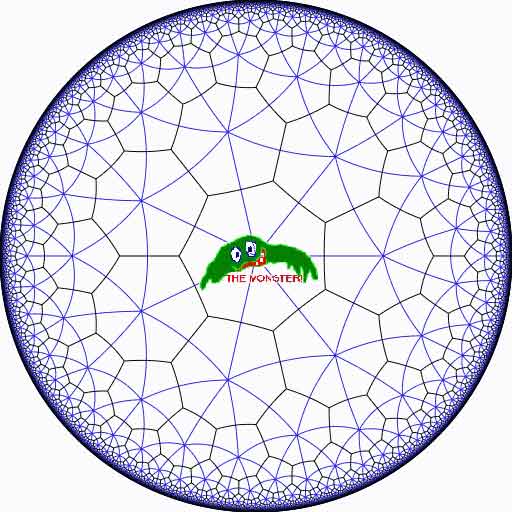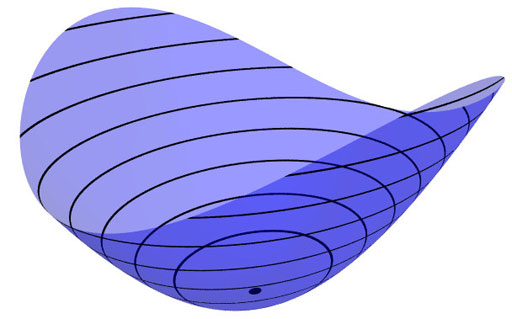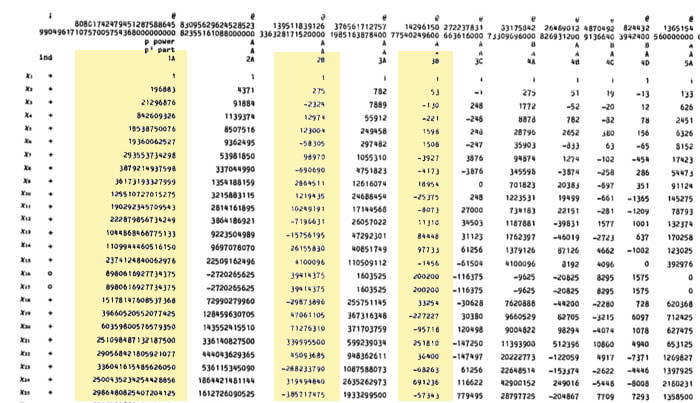A quick recap of last time. We are trying to make sense of affine varieties over the elusive field with one element $\mathbb{F}_1 $, which by Grothendieck’s scheme-philosophy should determine a functor
$\mathbf{nano}(N)~:~\mathbf{abelian} \rightarrow \mathbf{sets} \qquad A \mapsto N(A) $
from finite Abelian groups to sets, typically giving pretty small sets $N(A) $. Using the F_un mantra that $\mathbb{Z} $ should be an algebra over $\mathbb{F}_1 $ any $\mathbb{F}_1 $-variety determines an integral scheme by extension of scalars, as well as a complex variety (by extending further to $\mathbb{C} $). We have already connected the complex variety with the original functor into a gadget that is a couple $~(\mathbf{nano}(N),\mathbf{maxi}(R)) $ where $R $ is the coordinate ring of a complex affine variety $X_R $ having the property that every element of $N(A) $ can be realized as a $\mathbb{C} A $-point of $X_R $. Ringtheoretically this simply means that to every element $x \in N(A) $ there is an algebra map $N_x~:~R \rightarrow \mathbb{C} A $.
Today we will determine which gadgets determine an integral scheme, and do so uniquely, and call them the sought for affine schemes over $\mathbb{F}_1 $.
Let’s begin with our example : $\mathbf{nano}(N) = \underline{\mathbb{G}}_m $ being the forgetful functor, that is $N(A)=A $ for every finite Abelian group, then the complex algebra $R= \mathbb{C}[x,x^{-1}] $ partners up to form a gadget because to every element $a \in N(A)=A $ there is a natural algebra map $N_a~:~\mathbb{C}[x,x^{-1}] \rightarrow \mathbb{C} A $ defined by sending $x \mapsto e_a $. Clearly, there is an obvious integral form of this complex algebra, namely $\mathbb{Z}[x,x^{-1}] $ but we have already seen that this algebra represents the mini-functor
$\mathbf{min}(\mathbb{Z}[x,x^{-1}])~:~\mathbf{abelian} \rightarrow \mathbf{sets} \qquad A \mapsto (\mathbb{Z} A)^* $
and that the group of units $(\mathbb{Z} A)^* $ of the integral group ring $\mathbb{Z} A $ usually is a lot bigger than $N(A)=A $. So, perhaps there is another less obvious $\mathbb{Z} $-algebra $S $ doing a much better job at approximating $N $? That is, if we can formulate this more precisely…
In general, every $\mathbb{Z} $-algebra $S $ defines a gadget $\mathbf{gadget}(S) = (\mathbf{mini}(S),\mathbf{maxi}(S \otimes_{\mathbb{Z}} \mathbb{C})) $ with the obvious (that is, extension of scalars) evaluation map
$\mathbf{mini}(S)(A) = Hom_{\mathbb{Z}-alg}(S, \mathbb{Z} A) \rightarrow Hom_{\mathbb{C}-alg}(S \otimes_{\mathbb{Z}} \mathbb{C}, \mathbb{C} A) = \mathbf{maxi}(S \otimes_{\mathbb{Z}} \mathbb{C})(A) $
Right, so how might one express the fact that the integral affine scheme $X_T $ with integral algebra $T $ is the ‘best’ integral approximation of a gadget $~(\mathbf{nano}(N),\mathbf{maxi}(R)) $. Well, to begin its representing functor should at least contain the information given by $N $, that is, $\mathbf{nano}(N) $ is a sub-functor of $\mathbf{mini}(T) $ (meaning that for every finite Abelian group $A $ we have a natural inclusion $N(A) \subset Hom_{\mathbb{Z}-alg}(T, \mathbb{Z} A) $). As to the “best”-part, we must express that all other candidates factor through $T $. That is, suppose we have an integral algebra $S $ and a morphism of gadgets (as defined last time)
$f~:~(\mathbf{nano}(N),\mathbf{maxi}(R)) \rightarrow \mathbf{gadget}(S) = (\mathbf{mini}(S),\mathbf{maxi}(S \otimes_{\mathbb{Z}} \mathbb{C})) $
then there ought to be $\mathbb{Z} $-algebra morphism $T \rightarrow S $ such that the above map $f $ factors through an induced gadget-map $\mathbf{gadget}(T) \rightarrow \mathbf{gadget}(S) $.
Fine, but is this definition good enough in our trivial example? In other words, is the “obvious” integral ring $\mathbb{Z}[x,x^{-1}] $ the best integral choice for approximating the forgetful functor $N=\underline{\mathbb{G}}_m $? Well, take any finitely generated integral algebra $S $, then saying that there is a morphism of gadgets from $~(\underline{\mathbb{G}}_m,\mathbf{maxi}(\mathbb{C}[x,x^{-1}]) $ to $\mathbf{gadget}(S) $ means that there is a $\mathbb{C} $-algebra map $\psi~:~S \otimes_{\mathbb{Z}} \mathbb{C} \rightarrow \mathbb{C}[x,x^{-1}] $ such that for every finite Abelian group $A $ we have a commuting diagram
$\xymatrix{A \ar[rr] \ar[d]_e & & Hom_{\mathbb{Z}-alg}(S, \mathbb{Z} A) \ar[d] \\
Hom_{\mathbb{C}-alg}(\mathbb{C}[x,x^{-1}],\mathbb{C} A) \ar[rr]^{- \circ \psi} & & Hom_{\mathbb{C}-alg}(S \otimes_{\mathbb{Z}} \mathbb{C}, \mathbb{C} A)} $
Here, $e $ is the natural evaluation map defined before sending a group-element $a \in A $ to the algebra map defined by $x \mapsto e_a $ and the vertical map on the right-hand side is extensions by scalars. From this data we must be able to show that the image of the algebra map
$\xymatrix{S \ar[r]^{i} & S \otimes_{\mathbb{Z}} \mathbb{C} \ar[r]^{\psi} & \mathbb{C}[x,x^{-1}]} $
is contained in the integral subalgebra $\mathbb{Z}[x,x^{-1}] $. So, take any generator $z $ of $S $ then its image $\psi(z) \in \mathbb{C}[x,x^{-1}] $ is a Laurent polynomial of degree say $d $ (that is, $\psi(z) = c_{-d} x^{-d} + \ldots c_{-1} x^{-1} + c_0 + c_1 x + \ldots + c_d x^d $ with all coefficients a priori in $\mathbb{C} $ and we need to talk them into $\mathbb{Z} $).
Now comes the basic trick : take a cyclic group $A=C_N $ of order $N > d $, then the above commuting diagram applied to the generator of $C_N $ (the evaluation of which is the natural projection map $\pi~:~\mathbb{C}[x.x^{-1}] \rightarrow \mathbb{C}[x,x^{-1}]/(x^N-1) = \mathbb{C} C_N $) gives us the commuting diagram
$\xymatrix{S \ar[r] \ar[d] & S \otimes_{\mathbb{Z}} \mathbb{C} \ar[r]^{\psi} & \mathbb{C}[x,x^{-1}] \ar[d]^{\pi} \\
\mathbb{Z} C_n = \frac{\mathbb{Z}[x,x^{-1}]}{(x^N-1)} \ar[rr]^j & & \frac{\mathbb{C}[x,x^{-1}]}{(x^N-1)}} $
where the horizontal map $j $ is the natural inclusion map. Tracing $z \in S $ along the diagram we see that indeed all coefficients of $\psi(z) $ have to be integers! Applying the same argument to the other generators of $S $ (possibly for varying values of N) we see that , indeed, $\psi(S) \subset \mathbb{Z}[x,x^{-1}] $ and hence that $\mathbb{Z}[x,x^{-1}] $ is the best integral approximation for $\underline{\mathbb{G}}_m $.
That is, we have our first example of an affine variety over the field with one element $\mathbb{F}_1 $ : $~(\underline{\mathbb{G}}_m,\mathbf{maxi}(\mathbb{C}[x,x^{-1}]) \rightarrow \mathbf{gadget}(\mathbb{Z}[x,x^{-1}]) $.
What makes this example work is that the infinite group $\mathbb{Z} $ (of which the complex group-algebra is the algebra $\mathbb{C}[x,x^{-1}] $) has enough finite Abelian group-quotients. In other words, $\mathbb{F}_1 $ doesn’t see $\mathbb{Z} $ but rather its profinite completion $\hat{\mathbb{Z}} = \underset{\leftarrow} \mathbb{Z}/N\mathbb{Z} $… (to be continued when we’ll consider noncommutative $\mathbb{F}_1 $-schemes)
In general, an affine $\mathbb{F}_1 $-scheme is a gadget with morphism of gadgets
$~(\mathbf{nano}(N),\mathbf{maxi}(R)) \rightarrow \mathbf{gadget}(S) $ provided that the integral algebra $S $ is the best integral approximation in the sense made explicit before. This rounds up our first attempt to understand the Connes-Consani approach to define geometry over $\mathbb{F}_1 $ apart from one important omission : we have only considered functors to $\mathbf{sets} $, whereas it is crucial in the Connes-Consani paper to consider more generally functors to graded sets. In the final part of this series we’ll explain what that’s all about.




